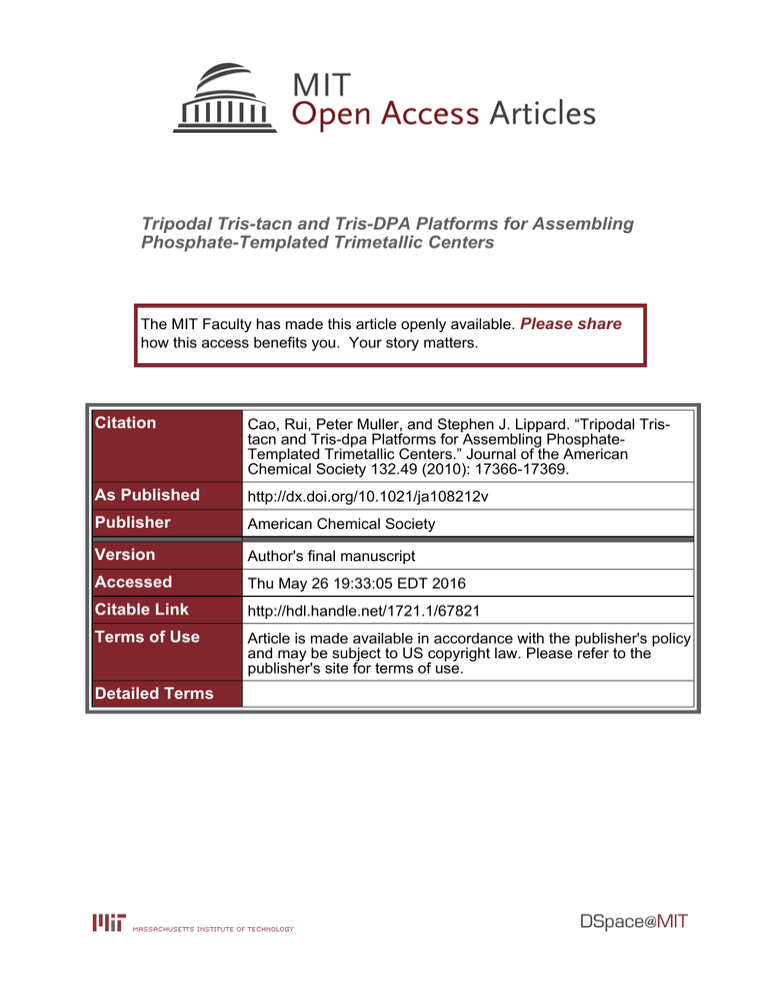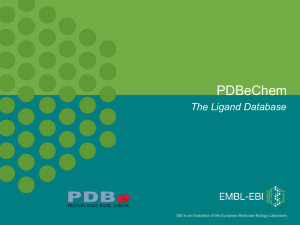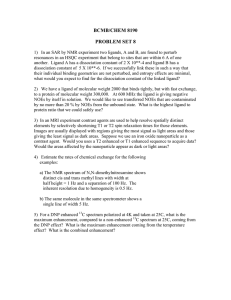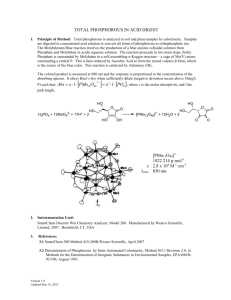Tripodal Tris-tacn and Tris-DPA Platforms for Assembling Phosphate-Templated Trimetallic Centers Please share
advertisement

Tripodal Tris-tacn and Tris-DPA Platforms for Assembling
Phosphate-Templated Trimetallic Centers
The MIT Faculty has made this article openly available. Please share
how this access benefits you. Your story matters.
Citation
Cao, Rui, Peter Muller, and Stephen J. Lippard. “Tripodal Tristacn and Tris-dpa Platforms for Assembling PhosphateTemplated Trimetallic Centers.” Journal of the American
Chemical Society 132.49 (2010): 17366-17369.
As Published
http://dx.doi.org/10.1021/ja108212v
Publisher
American Chemical Society
Version
Author's final manuscript
Accessed
Thu May 26 19:33:05 EDT 2016
Citable Link
http://hdl.handle.net/1721.1/67821
Terms of Use
Article is made available in accordance with the publisher's policy
and may be subject to US copyright law. Please refer to the
publisher's site for terms of use.
Detailed Terms
Tripodal Tris-tacn and Tris-DPA Platforms for Assembling Phosphate-Templated
Trimetallic Centers
Rui Cao, Peter Müller, and Stephen J. Lippard*
Department of Chemistry, Massachusetts Institute of Technology, Cambridge, Massachusetts 02139
RECEIVED DATE (automatically inserted by publisher); E-mail: lippard@mit.edu
Scheme 1.
Abstract: Multidentate tripodal ligands, N(CH2-m-C6H4CH2tacn)3 (L1) and N(CH2-o-C6H4-CH2N(CH2py)2)3 (L2),
have been devised for assembling high-nuclearity metal
clusters. By using the same tripodal platform with different
ligand appendages, either triazacyclononanes or dipicolylamines, and functionalizing either the ortho or the meta
positions on the tris(xylyl) linker arms, discrete trimetalphosphate units of relevance to phosphate-metabolizing
trimetallic centers in biology were prepared. Four such
compounds, [(CuIICl)3(HPO4)L1](PF6) (1), [(CuIICl)3(HAsO4)L1](PF6) (2), Na2[MnIII6MnII2(H2O)2(HPO4)6(PO4)4(L1)2] (3), and [CoII3(H2PO4)Cl2(MeCN)L2](PF6)3
(4), all containing three metal centers bound to a central
phosphate or arsenate unit bridging oxygen atoms, have
been synthesized and structurally characterized. These results demonstrate the propensity of this novel tripodal
ligand platform, in the presence of phosphate or arsenate,
to assemble {M3(EO4)} units and thus structurally mimic
trimetallic active sites of proteins involved in phosphate
metabolism. Reactivity studies reveal that the tricopper
complex 1 is more efficient than the monocopper analogues
in catalyzing the hydrolysis of 4-nitrophenyl phosphate.
Metalloproteins containing three metal ions at their active
sites perform a variety of important biological functions,1 including the 4-electron reduction of dioxygen to water by laccase and other multicopper oxidases,2-5 the hydrolysis of phosphoric acid monoesters,6,7 phospholipids,8,9 nucleotides10,11 and
inorganic pyrophosphate12,13 by enzymes having a diverse
array of divalent metal ions, and the mediation of electron
transfer by 3Fe-3(4)S containing proteins.14,15 Phosphoric acid
derivatives including phosphates also play a dominant role in
biology,16 including metabolic energy storage as adenosine
triphosphate (ATP) and energy generation by metal-phosphate
(MHPO4) chelates.17-19 Phosphate mono- and diesters are important structural components of lipids and macromolecules of
the genome, and protein function is widely regulated by reversible phosphorylation of amino acid side chains.
Many enzymes required for phosphate metabolism contain a
trimetallic active site.1 Such trimetallic centers in P1 nuclease,10,11 alkaline phosphatases,6,20,21 phospholipase C,8,9 and
inorganic pyrophosphatases12,13 are responsible for cleavage of
phosphate P–O bonds; the trimetallic centers in PhoU proteins
are involved in inorganic phosphate uptake and regulation.22,23
In addition, some proteins, like T5 flap endonuclease, have
only two divalent metal ions bound in the active site in the
absence of phosphates but bind a third metal ion in the pres-
N
O
N
N
M
O
M
P O
O
N
N
N
N
N
M
N
N
ence of substrates,24 which implies a weak association constant for the third metal and a templating effect of phosphate
substrates in the protein active site. The use of three metal ions
to hydrolyze phosphates is believed to anchor and orient them
in a position best suited for bond cleavage. As shown in
Scheme 1 (left), the X-ray structure of a family II pyrophosphatase reveals an M3 site bridged by the {PO4} unit, with
each metal connected to one of the three O atoms of the phosphate and a nucleophilic water molecule below the M3 plane.13
Many artificial phosphates/nucleases have been developed
for applications in biotechnology and medicine, and multiple
metal ions in a single molecule can endow unique activity.25-30
Despite such achievements, however, no discrete structural
model having a trimetallic center linked by a phosphate group
within a single ligand framework to mimic the protein
{M3(PO4)} cores is available to our knowledge.7,13 We report
here a tripodal platform in which ligand arms at either the
meta or ortho positions of a tris(xylyl) scaffold can each bind
one metal ion with phosphate or arsenate to self-assemble the
desired core. The resulting structures have a tetrahedral anion
binding to each metal through one of three facial oxygen atoms similar to the coordination observed in protein active sites
(Scheme 1, right). Four such complexes with different metal
ions, ligand arms, and arm positions have been obtained and
all were structurally characterized, indicating the versatility of
this tripodal platform. Moreover, reactivity studies reveal that
the hydrolysis of 4-nitrophenyl phosphate is accelerated by the
tricopper complex 1, which is catalytically more efficient than
its monocopper analogues.
In the course of developing multidentate ligands to coordinate trimetallic clusters, we found that a tribenzylamine scaffold provides the appropriate platform to draw three ligand
arms together at the requisite spacing to accommodate a
trimetal-phosphate core. Crystallographic studies of a prototypical tripodal ligand backbone of this kind, N(CH2-p-C6H4CONH2)3 (Figure 1), the syntheses and properties of which are
supplied in Supporting Information, indicated that three symmetric ligand arms connected via para positions produce a
flattened structure lacking the pre-organized ligand environment suitable for assembling a trimetallic cluster. However,
the structure revealed that ligand arms at the meta or ortho
upward m-
downward m-
downward o-
Figure 1. Ball-and-stick representation of the X-ray structure of a
tripodal ligand model N(CH2-p-C6H4-CONH2)3. The C, O, N and H
atoms are depicted in black, red, light blue, and light pink, respectively. The upward and downward meta-position and downward ortho-positions are labeled.
positions would produce the desired geometric configuration.
We therefore placed three 1,4,7-triazacyclononane (tacn)
ligand arms at the meta positions of the tribenzylamine platform, and this effort gave the novel tris-tacn tripodal clusterforming ligand, N(CH2-m-C6H4-CH2tacn)3 (L1) (syntheses and
details in SI). The choice of tacn ligand arms was based on the
well-known facial coordination and high binding affinity of
this unit for most transition metals.31-33 Although ligands with
2, 3 or 4 tacn moieties linked by a phenyl group have been
reported previously, in no case was a discrete trinuclear metal
complex formed having a central phosphate bridge.34-40
Reaction of L1 with CuCl2 in the presence of HPO42- under
ambient conditions gave a clear blue solution after filtration.
Addition of NH4(PF6) to this clear solution and subsequent
evaporation in air afforded crystalline prisms of [(CuIICl)3(HPO4)L1](PF6) (1). Complex 1 crystallizes in the trigonal
space group R 3 with the monocationic cluster having a crystallographically required C3 axis passing through the tetrahe€
Figure 2. Thermal ellipsoid plots (50% probability) of the X-ray
structure of complex 1. The C3 axis passes through O2, P1 and N1
atoms. Hydrogen atoms are omitted for clarity.
dral phosphate (O2 and P1) and nitrogen (N1) atoms (Figure
2). Each of the three symmetric ligand arms of L1 coordinates
one Cu(II) atom using three N atoms of the tacn moiety, and
the three Cu atoms are bridged by the phosphate group with
each Cu connected to one of the three facial oxygen atoms. A
terminal chloride ligand on each Cu completes the coordination sphere and results in a distorted square-pyramidal geometry with the tertiary nitrogen atom (N2) at the apex (Cu1-N2,
2.256(3) Å). The fourth, uncoordinated oxygen atom (O2) of
the phosphate is protonated, as revealed by the longer P1–O2
bond distance of 1.585(5) Å compared to P1–O1 = 1.516(2) Å.
Monoprotonation of O2 is further confirmed by charge balance, with one PF6– counterion per trimetallic cluster being
located both in the X-ray structure and by elemental analysis.
The molecular structure of 1 demonstrates that the tacnbased tripodal ligand N(CH2-m-C6H4-CH2tacn)3 (L1) can bind
three metal centers to afford the {(CuCl)3(HPO4)}+ core in the
presence of phosphate ion. Although, as shown in Figure 1,
the ligand arms at the meta positions of the tribenzylamine
linker can have either an upward or downward orientation, the
templating effect of the phosphate group selects the former to
afford the desired trimetallic core. This conclusion is supported by studies of the ligand precursor N(CH2-m-C6H4CH2Br)3, in which the three bromomethyl arms adopt a
downward orientation in the solid state (Figure S2). Presumably, this geometric configuration is thermodynamically more
stabile prior to introduction of the phosphate anion to form 1.
The arsenic analogue of 1 was also synthesized and structurally characterized. Replacement of HPO42- with HAsO42-, in
the reaction of L1 and CuCl2 followed by addition of PF6–
anion gave small crystalline cubes of [(CuIICl)3(HAsO4)L1](PF6) (2). The structure matches that of the phosphate analogue (Figure S5), in which a {(CuCl)3(HAsO4)}+
core is coordinated by L1 with each Cu(II) bound to three N
atoms of a tacn-based ligand arm. The monocationic cluster
has C3 symmetry and its charge is balanced by a PF6– counterion. The As–O distances (As1–O1 1.576(8) Å, As1–O2
1.623(17) Å) are longer than the P–O distances P1–O1 =
1.516(2) Å and P1–O2 = 1.585(5) Å), a result consistent to the
larger ionic radius of As(V) vs P(V).
Reaction of ligand L1 with the dinuclear manganese complex [MnIII2(µ-O)(µ-OAc)2(bpy)2Cl2] in the presence of
HPO42- gave Na2[MnIII6MnII2(H2O)2(HPO4)6(PO4)4(L1)2] (3) as
red crystalline prisms. Crystallographic studies revealed a
remarkable octamanganese cluster flanked by two symmetry
equivalent L1 ligands and overall Ci site symmetry (Figure 3).
Alternatively, the structure of 3 can be described as a dimer of
two symmetry-equivalent trimetallic {Mn3L1}3- units connected by two additional Mn atoms. In each {Mn3L1}3- unit,
three manganese atoms are each coordinated by one tacnbased ligand arm through its three nitrogen atoms and additionally linked by a phosphate group (P1). The resulting
{Mn3(PO4)}6+ core is thus stabilized within the tripodal
framework of ligand L1. The ligand arms in 3 are directed in
the upward orientation, thereby resembling the geometric configuration observed in the structures of 1 and 2.
In each {Mn3L1}3- unit, Mn1 has a terminal phosphate
group (P2) and an aqua ligand to complete a 6-coordinate,
octahedral environment. The Mn2 and Mn3 atoms are each
P2
Mn1
Mn3
Mn2
P1
P4
P3
P5
Mn4
Mn4
P5
P3
P4
Mn2
P1
Mn1
P2
Mn3
Figure 3. Thermal ellipsoid plots (30% probability) of the {Mn3L1}
subunit of complex 3 (top). Ball-and-stick representation of the
{Mn8(HPO4)6(PO4)4}2- core cluster of 3 (bottom). In the bottom part,
the ligand backbone of L1 is omitted. The Mn, P, O and N atoms are
shown in purple, orange, red and blue, respectively.
linked to the Mn4 atom through a bidentate bridging phosphate (P4 and P3, respectively) group and another such group
(P5 and P5, respectively) that also uses one of its coordinated
oxygen atoms to bridge to a third Mn atom. The Mn4 atom
additionally binds to a fourth oxygen atom supplied by the P1
phosphate. The binding pattern of the resulting inorganic
{Mn8(HPO4)6(PO4)4}2- core is also depicted in Figure 3. A
crystallographically imposed inversion center is located at the
midpoint of the Mn4-Mn4 vector.
The three Mn atoms in the {Mn3L1}3- unit are all in the +3
oxidation state, as established by a bond valence sum (BVS)
analysis as well as the existence of a Jahn-Teller (JT) elongation axis, typical of high-spin d4 Mn(III) ions. The central
Mn4 atoms, however, have a d5 Mn(II) electronic configuration (BVS = 2.05), Mn(II) probably forming by disproportionation of Mn(III). Careful examination of the phosphate
groups indicated the presence of six HPO42- and four PO43units. Taken together, these considerations establish the formula as [MnIII6MnII2(H2O)2(HPO4)6(PO4)4(L1)2]2-, with two
Na+ counterions. The absence of Cl– as counterion is confirmed by elemental analysis (Supporting Information), which
further supports the above formulation of 3.
A related trinucleating ligand based on the same tribenzylamine platform has been prepared. As noted from the structure of N(CH2-p-C6H4-CONH2)3, ligand arms at the ortho positions can also give rise to a pre-organized environment capable of forming a trimetallic center. We therefore prepared
N(CH2-o-C6H4-CH2N(CH2py)2)3 (L2) in which three bis(2pyridylmethyl)amine (dpa) ligand arms were appended to ortho positions in the tribenzylamine platform. The synthesis
and details are available in supporting information. Reaction
of L2 and CoCl2 in the presence of H2PO4– gave a clear pinkpurple solution. Addition of NH4(PF6) to the reaction solution
and vapor diffusion using diethyl ether at room temperature
afforded crystalline purple prisms of [CoII3(H2PO4)Cl2(MeCN)L2](PF6)3 (4). In 4, three Co(II) atoms, the oxidation states of which are supported by a BVS calculation (Supporting Information), are each bound by one L2 dpa ligand
appendage through three N atoms and linked by a central
H2PO4– group (Figure 4). Co1 has a trigonal bipyramidal coordination sphere with a terminal Cl ligand at the apex trans to
the tertiary nitrogen atom (N2). Co2 and Co3 are further
bridged by a Cl– ligand (Cl2). Co2 also has trigonal bipyramidal stereochemistry, with Cl2 at the apex trans to the tertiary
nitrogen atom (N5), whereas Co3 is six-coordinate with a terminal MeCN ligand trans to the tertiary nitrogen atom (N8).
The resulting trimetallic cluster [CoII3(H2PO4)Cl2(MeCN)L2]3+
is charge-balanced by three PF6– ions that were also located in
the X-ray structure.
The structures of 1-4 represent the first examples in which a
trimetal-phosphate/arsenate unit is stabilized in a discrete
ligand environment. As such, they serve as structural mimics
of trimetal-phosphate enzyme active sites.7,13 The occurrence
of this unit in diverse complexes illustrates the value of using
the new trinucleating ligands in conjunction with bridging
tetrahedral anions like phosphate or arsenate.
In order to examine the potential for such complexes to
serve as metallohydrolase catalysts, we studied the hydrolysis
Figure 4. Thermal ellipsoid plots (50% probability) of the X-ray
structure of 4.
of 4-nitrophenyl phosphate in the presence of the tricopper(II)complex 1. As deduced by a high-resolution ESI-MS
measurement (Figure S9, Supporting Information), the monocationic cluster 1 stays intact upon dissolution. This hydrolytic
reaction produces inorganic phosphate and 4-nitrophenol,
which can be readily detected spectroscopically by its strong
electronic absorption at ~ 400 nm).41,42 Kinetic studies revealed that the hydrolysis of 4-nitrophenyl phosphate is accelerated by 1 (Figure S10). We also investigated this hydrolysis
reaction using the mononuclear copper tacn complex
[Cu(tacn)Cl2], which structurally resembles a single ligand
arm of 1. The observed hydrolysis rate constant, kobs, for 1
(5.32 × 10-7 s-1) is 12 times greater than that of [Cu(tacn)Cl2]
(4.35 × 10-8 s-1 under equimolar copper concentrations), which
suggests that the three close copper atoms in close proximity
may work together with greater efficiency than mononuclear
copper species in catalyzing the hydrolysis of 4-nitrophenyl
phosphate.
In conclusion, by using tripodal ligand N(CH2-m-C6H4CH2tacn)3 (L1) or N(CH2-o-C6H4-CH2N(CH2py)2)3 (L2),
trimetal-phosphate or -arsenate units that mimic natural sites
in phosphate metabolizing enzymes were accessed in discrete
molecular system. Four compounds, all containing such a
trimetallic core, were prepared and structurally characterized,
[(CuIICl)3(HPO4)L1](PF6) (1), [(CuIICl)3(HAsO4)L1](PF6) (2),
Na2[MnIII6MnII2(H2O)2(HPO4)6(PO4)4(L1)2]
(3),
and
[CoII3(H2PO4)Cl2(MeCN)L2](PF6)3 (4). In all four compounds,
three metal ions are each bound by one arm of the tripodal
ligand through three N atoms and further linked by a tetrahedral phosphate, protonated phosphate, or protonated arsenate
group. The resulting structures reprise features of the phosphate-bridged trimetallic active sites in several proteins involved in phosphate metabolism.7,13 Complex 1 catalyzes the
hydrolysis of 4-nitrophenyl phosphate with a greater efficiency than its mononuclear Cu(II) tacn analogue, a result
suggesting that three copper atoms in close proximity provide
an advantage for effecting this chemistry.
Acknowledgments. This work was supported by a grant from the
Camille and Henry Dreyfus Foundation. We thank Dr. William H.
Armstrong for helpful discussions.
Supporting Information Available: Complete synthesis and
characterization of the tripodal model complex N(CH2-p-C6H4CONH2)3, tripodal ligands L1 and L2, metal complexes 1-4. Xray data as CIF files of N(CH2-p-C6H4-CONH2)3, N(CH2-mC6H4-CH2Br)3,
N(CH2-o-C6H4-CH2OH)3,
[MnIII2(µ-O)(µOAc)2(bpy)2Cl2], and metal complexes 1-4. Hydrolysis studies of
NPP. Scheme S1-S3, Table S1-S8, and Figure S1-S10. This material is available free of charge via the Internet at
http://pubs.acs.org.
References
(1)
Fenton, D. E.; Okawa, H. J. Chem. Soc., Dalton Trans. 1993, 13491357.
(2)
Sundaram, U. M.; Zhang, H. H.; Hedman, B.; Hodgson, K. O.; Solomon, E. I. J. Am. Chem. Soc. 1997, 119, 12525-12540.
(3)
Yoon, J.; Liboiron, B. D.; Sarangi, R.; Hodgson, K. O.; Hedman, B.;
Solomona, E. I. Proc. Natl. Acad. Sci. USA 2007, 104, 13609-13614.
(4)
Quintanar, L.; Stoj, C.; Taylor, A. B.; Hart, P. J.; Kosman, D. J.;
Solomon, E. I. Acc. Chem. Res. 2007, 40, 445-452.
(5)
Augustine, A. J.; Kjaergaard, C.; Qayyum, M.; Ziegler, L.; Kosman,
D. J.; Hodgson, K. O.; Hedman, B.; Solomon, E. I. J. Am. Chem. Soc.
2010, 132, 6057-6067.
(6)
(7)
(8)
(9)
(10)
(11)
(12)
(13)
(14)
(15)
(16)
(17)
(18)
(19)
(20)
(21)
(22)
(23)
(24)
(25)
(26)
(27)
(28)
(29)
(30)
(31)
(32)
(33)
(34)
(35)
(36)
(37)
(38)
(39)
(40)
(41)
(42)
Stec, B.; Holtz, K. M.; Kantrowitz, E. R. J. Mol. Biol. 2000, 299,
1303-1311.
Omi, R.; Goto, M.; Miyahara, I.; Manzoku, M.; Ebihara, A.; Hirotsu,
K. Biochemistry 2007, 46, 12618-12627.
Hough, E.; Hansen, L. K.; Birknes, B.; Jynge, K.; Hansen, S.; Hordvik, A.; Little, C.; Dodson, E.; Derewenda, Z. Nature 1989, 338, 357360.
Hansen, S.; Kristian, L.; Hough, H.; Hough, E. J. Mol. Biol. 1992,
225, 543-549.
Lahm, A.; Volbeda, A.; Suck, D. J. Mol. Biol. 1990, 215, 207-210.
Volbeda, A.; Lahm, A.; Sakiyama, F.; Suck, D. EMBO J. 1991, 10,
1607-1618.
Cooperman, B. S.; Baykov, A. A.; Lahti, R. Trends Biochem. Sci
1992, 17, 262-266.
Fabrichniy, I. P.; Lehtio, L.; Tammenkoski, M.; Zyryanov, A. B.; Oksanen, E.; Baykov, A. A.; Lahti, R.; Goldman, A. J. Biol. Chem. 2007,
282, 1422-1431.
Beinert, H.; Thomson, A. J. Arch. Biochem. Biophys. 1983, 222, 333361.
Holm, R. H. Adv. Inorg. Chem. 1992, 38, 1-71.
Bowler, M. W.; Cliff, M. J.; Waltho, J. P.; Blackburn, G. M. New J.
Chem. 2010, 34, 784-794.
Vanveen, H. W.; Abee, T.; Kortstee, G. J. J.; Konings, W. N.;
Zehnder, A. J. B. Biochemistry 1994, 33, 1766-1770.
Vanveen, H. W.; Abee, T.; Kortstee, G. J. J.; Konings, W. N.;
Zehnder, A. J. B. J. Biol. Chem. 1994, 269, 16212-16216.
Konings, W. N.; Lolkema, J. S.; Poolman, B. Arch. Microbiol. 1995,
164, 235-242.
Kim, E. E.; Wyckoff, H. W. J. Mol. Biol. 1991, 218, 449-464.
Le Du, M. H.; Stigbrand, T.; Taussig, M. J.; Menez, A.; Stura, E. A. J.
Biol. Chem. 2001, 276, 9158-9165.
Steed, P. M.; Wanner, B. L. J. Bacteriol. 1993, 175, 6797-6809.
Liu, J. Y.; Lou, Y.; Yokota, H.; Adams, P. D.; Kim, R.; Kim, S. H. J.
Biol. Chem. 2005, 280, 15960-15966.
Syson, K.; Tomlinson, C.; Chapados, B. R.; Sayers, J. R.; Tainer, J.
A.; Williams, N. H.; Grasby, J. A. J. Biol. Chem. 2008, 283, 2874128746.
Komiyama, M.; Kina, S.; Matsumura, K.; Sumaoka, J.; Tobey, S.;
Lynch, V. M.; Anslyn, E. V. J. Am. Chem. Soc. 2002, 124, 1373113736.
Humphreys, K. J.; Karlin, K. D.; Rokita, S. E. J. Am. Chem. Soc.
2002, 124, 8055-8066.
Cacciapaglia, R.; Casnati, A.; Mandolini, L.; Peracchi, A.; Reinhoudt,
D. N.; Salvio, R.; Sartori, A.; Ungaro, R. J. Am. Chem. Soc. 2007,
129, 12512-12520.
Williams, N. H.; Takasaki, B.; Wall, M.; Chin, J. Acc. Chem. Res.
1999, 32, 485-493.
Molenveld, P.; Engbersen, J. F. J.; Reinhoudt, D. N. Chem. Soc. Rev.
2000, 29, 75-86.
Morrow, J. R.; Iranzo, O. Curr. Opin. Chem. Biol. 2004, 8, 192-200.
Hartman, J. A. R.; Rardin, R. L.; Chaudhuri, P.; Pohl, K.; Wieghardt,
K.; Nuber, B.; Weiss, J.; Papaefthymiou, G. C.; Frankel, R. B.; Lippard, S. J. J. Am. Chem. Soc. 1987, 109, 7387-7396.
Wieghardt, K.; Bossek, U.; Nuber, B.; Weiss, J.; Bonvoisin, J.; Corbella, M.; Vitols, S. E.; Girerd, J. J. J. Am. Chem. Soc. 1988, 110,
7398-7411.
Bossek, U.; Weyhermuller, T.; Wieghardt, K.; Nuber, B.; Weiss, J. J.
Am. Chem. Soc. 1990, 112, 6387-6388.
Graham, B.; Fallon, G. D.; Hearn, M. T. W.; Hockless, D. C. R.;
Laarev, G.; Spiccia, L. Inorg. Chem. 1997, 36, 6366-6373.
Farrugia, L. J.; Lovatt, P. A.; Peacock, R. D. J. Chem. Soc., Dalton
Trans. 1997, 911-912.
Belousoff, M. J.; Graham, B.; Spiccia, L. Eur. J. Inorg. Chem. 2008,
4133-4139.
Spiccia, L.; Graham, B.; Hearn, M. T. W.; Lazarev, G.; Moubaraki,
B.; Murray, K. S.; Tiekink, E. R. T. J. Chem. Soc., Dalton Trans.
1997, 4089-4097.
Graham, B.; Spiccia, L.; Fallon, G. D.; Hearn, M. T. W.; Mabbs, F.
E.; Moubaraki, B.; Murray, K. S. J. Chem. Soc., Dalton Trans. 2002,
1226-1232.
Graham, B.; Hearn, M. T. W.; Junk, P. C.; Kepert, C. M.; Mabbs, F.
E.; Moubaraki, B.; Murray, K. S.; Spiccia, L. Inorg. Chem. 2001, 40,
1536-1543.
Battle, A. R.; Graham, B.; Spiccia, L.; Moubaraki, B.; Murray, K. S.;
Skelton, B. W.; White, A. H. Inorg. Chim. Acta 2006, 359, 289-297.
Tang, S. P.; Zhou, Y. H.; Chen, H. Y.; Zhao, C. Y.; Mao, Z. W.; Ji, L.
N. Chemistry-an Asian Journal 2009, 4, 1354-1360.
Steens, N.; Ramadan, A. M.; Absillis, G.; Parac-Vogt, T. N. Dalton
Transactions 2010, 39, 585-592.
N
O
N
N
X = P or As
M
O
M
X O
O
N
N
N
N
N
N
M
N






